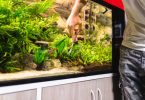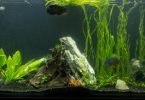You must be aware of the treatment for ammonia. Or even that for nitrite. But nitrate is harmful as well. When present in more amount. Not only ammonia, nitrite, and nitrate, but all are also bad for fishes. There are ways in which we can treat the nitrate level. Duckweed, Moss Ball, Water Lettuce are some plants that can be kept in the tank. These plants will help you get the usual amount of nitrate in water. We will discuss getting rid of nitrate in the fish tank. Although nitrate isn’t as lethal as ammonia, it still needs treatment.
How To Get Rid of Nitrates in Fish Tank
Change of water from the fish tank
The continuous change of water from the tank should be prioritized. Although it is not good to only pour the entire water out of the tank. Nitrates are toxic to fishes. Also, they need to be present in the tank in a certain amount. And with that amount they are not harmful to the fishes.
One can change almost 40-50% of water. Some people suggest going for 25-30% of the water every two weeks. But only if you have got a big fish tank. Never pour too much water out of the tank. It will only lead to harm to the fishes somehow. And that is not even required. Changing a particular amount is just fine to keep the level of nitrate as less than 20 ppm. But we suggest that reducing of almost half the amount of water will be beneficial. And lead to a very less amount of nitrate, which is good even if you remove only 25% of water. Then by adding the freshwater, you will get at least 20 ppm of nitrates. Meanwhile, if you choose the 40% removal idea, then there is a chance of getting it to reduce to 5 ppm in a very less time which is indeed beneficial than 20 ppm.
Addition of plants inside the fish tank
We have mentioned some plants earlier. It is because plants are the excellent consumer of nitrate. And some other plants are Limnobium Laevigatum, Marimo. They can consume nitrate when at a high rate. Also, it provides a suitable environment for fishes. Fishes in the fish tank will regain their activeness as well.
Also, an algae explosion can help. When the level of nitrate is high, introduce algae in the tank.
Cleaning of filters of the fish tank
Filters should be taken care of. They are one factor that affects the health of fish. The environment around the fish is essential. Same as cleaning of water and plants, filter cleaning is also necessary. You can either clean them regularly. Or try to change or replace them. Change them only when the filter has been used for a long time. Or you can simply purify and clean them. Cleaning is crucial.
Balanced pH in a fish tank
The adjustment of pH is critical as well. It will help the fishes to avoid the well-known “pH shock”. Ph balance should be checked regularly. Both increment or decrement of pH is harmful. While changing the tank for fishes, keep pH in mind. More water or less water can both change the pH. One can add baking soda with water in the tank. It can help you get the desired amount of Ph.
Feeding your fishes
Each one of you knows that there is an age-old saying, “excess of everything is bad”. Here as well, this saying is applicable. Never feed your fish too much as this will lead to more release of fecal matter. Then ammonia and further decomposition into nitrite and nitrate.
Is Nitrate in Fish Tank As Dangerous as Ammonia?
Some people own a fish tank, yet they consider the safety of fishes when there is an increase in the amount of ammonia. Seldom do they care about nitrate. Nitrate isn’t lethal to the fishes, yet they are harmful in other ways. And can be found hazardous if not taken care of.
Nitrate is something obtained during the decomposition of ammonia as there is a presence of wastes such as fecal matter, food materials, bi-product of fish wastes. Organic matter decomposition handles the release of ammonia inside the fish tank. And further, it is converted into nitrate by nitrifying bacteria, and this is known as nitrification.
Nitrate Shock vs Nitrate Poisoning
Fixing the nitrate in the fish tank also depends on two factors. The first one is Nitrate SHOCK, and the other one is Nitrate POISONING. Both are inter-related yet different from each other. Let us consider the former one first, what is “nitrate shock”?
It is a level when fishes inside the tank are in contact with some unusual level of nitrate. It can be in a very high amount or very low. Both aren’t good in any sense. But “nitrate poisoning” is something when there is a rapid increase in the level of nitrate. The reason can be anything like overdosing the fishes and or even getting too many fishes inside a fish tank. Both are evenly responsible for the high rate of nitrate inside the fish tank.
There are several symptoms which can be observed during the rise of nitrate level in the fish tank; they are:
High respiration rate
This can be seen if you minutely observe the gill movement of fishes inside the tank. If they are continually moving it, then they are having a problem with respiration. It often happens when the fishes are in contact with a high level of nitrate for at least 24 hours.
Disorientation
There will be no co-ordination among the fishes. The way they move and swim is effortless during ordinary times. But this will not be seen, lately as they will look fatigued or tired.
Appetite loss
No longer will they come near the good or will be interested in it even if it is near to their mouth. You can often observe this behavior if you keep track of their food and appetite. They will often ignore the food and will stick to a corner. It is a sign which we can observe.
Fish Lying in the bottom
One significant sign which will be visible if your fish tank is poisoned with nitrate. The fishes won’t prefer moving inside the water; instead, they will lay at the bottom to avoid swimming.
Treatment
Changing the water in the fish tank can be an immediate treatment. But at first, take a quick nitrate check. It is crucial to do so now of emergency. By checking the nitrate level, you’ll have an idea of how much increment has been occurred — then cleaning of water, not only a vast amount of water to be thrown away from the fish tank. Instead, go for multiple times of water change. Some amount of water but after time to time. Also, keep track of feeding your fishes since they should not overfeed. It is one primary reason for the increment of nitrate as more they will eat and more will be the waste products out of them. This treatment measure is constructive to treat the nitrate in the tank.






